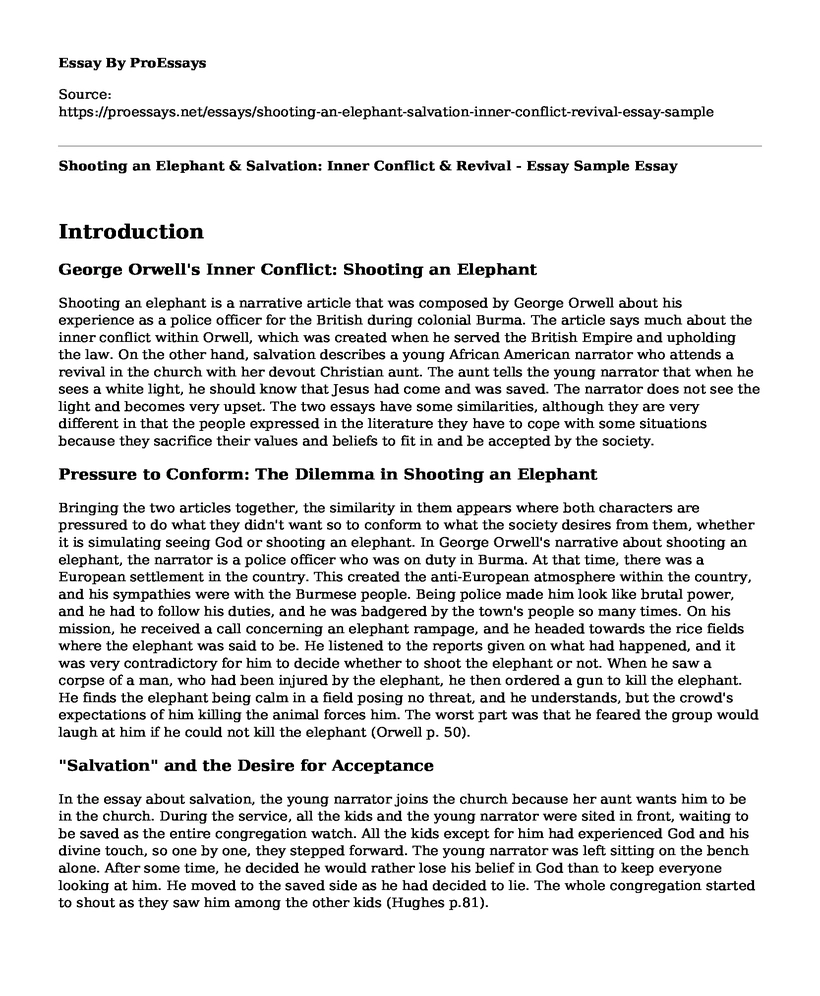Introduction
George Orwell's Inner Conflict: Shooting an Elephant
Shooting an elephant is a narrative article that was composed by George Orwell about his experience as a police officer for the British during colonial Burma. The article says much about the inner conflict within Orwell, which was created when he served the British Empire and upholding the law. On the other hand, salvation describes a young African American narrator who attends a revival in the church with her devout Christian aunt. The aunt tells the young narrator that when he sees a white light, he should know that Jesus had come and was saved. The narrator does not see the light and becomes very upset. The two essays have some similarities, although they are very different in that the people expressed in the literature they have to cope with some situations because they sacrifice their values and beliefs to fit in and be accepted by the society.
Pressure to Conform: The Dilemma in Shooting an Elephant
Bringing the two articles together, the similarity in them appears where both characters are pressured to do what they didn't want so to conform to what the society desires from them, whether it is simulating seeing God or shooting an elephant. In George Orwell's narrative about shooting an elephant, the narrator is a police officer who was on duty in Burma. At that time, there was a European settlement in the country. This created the anti-European atmosphere within the country, and his sympathies were with the Burmese people. Being police made him look like brutal power, and he had to follow his duties, and he was badgered by the town's people so many times. On his mission, he received a call concerning an elephant rampage, and he headed towards the rice fields where the elephant was said to be. He listened to the reports given on what had happened, and it was very contradictory for him to decide whether to shoot the elephant or not. When he saw a corpse of a man, who had been injured by the elephant, he then ordered a gun to kill the elephant. He finds the elephant being calm in a field posing no threat, and he understands, but the crowd's expectations of him killing the animal forces him. The worst part was that he feared the group would laugh at him if he could not kill the elephant (Orwell p. 50).
"Salvation" and the Desire for Acceptance
In the essay about salvation, the young narrator joins the church because her aunt wants him to be in the church. During the service, all the kids and the young narrator were sited in front, waiting to be saved as the entire congregation watch. All the kids except for him had experienced God and his divine touch, so one by one, they stepped forward. The young narrator was left sitting on the bench alone. After some time, he decided he would rather lose his belief in God than to keep everyone looking at him. He moved to the saved side as he had decided to lie. The whole congregation started to shout as they saw him among the other kids (Hughes p.81).
Both situations were different but similar in such a way that the experiences show how people adapt to fit in and be accepted by society, whether it is shooting an elephant or lying about to see God.
Works Cited
Hughes, Langston. Salvation. Films for the Humanities & Sciences. (2002)
Orwell, George. ''Shooting an elephant''. (1936)
Cite this page
Shooting an Elephant & Salvation: Inner Conflict & Revival - Essay Sample. (2023, Apr 14). Retrieved from https://proessays.net/essays/shooting-an-elephant-salvation-inner-conflict-revival-essay-sample
If you are the original author of this essay and no longer wish to have it published on the ProEssays website, please click below to request its removal:
- Anatomy and Physiology in Stress Conditions
- Essay Example on Ancient Egypt & Mesopotamia: Male-Dominated Societies
- Feminist Aesthetics: Examining Art Through Gender, Race, Class, & Nationality - Essay Sample
- Essay Example on Women's Rights: A Long Journey of Discrimination and Stereotypes
- Combating Islamophobia in Canada: Discrimination, Perspectives and Behaviors - Essay Sample
- Women in Ancient Greece & India: A Comparison - Research Paper
- Essay on Mexicans and Blacks in the USA: Uncovering Racial Discrimination







